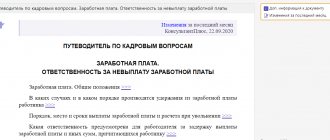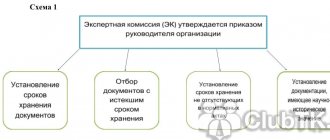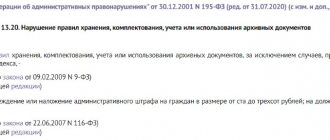How to store employee personal accounts and other documents
Selections from magazines for an accountant Details Category: Selections from magazines for an accountant Published: 11/22/2015 00:00 Source: Glavbukh magazine Website of the magazine “Salaries in an Institution” Electronic magazine “Salaries in an Institution” Articles on the topic
- Here's more news
- What new things have you learned about taxes, contributions and accounting?
- Portfolio managers lose confidence
Let us recall the procedure for storing personal accounts and other “salary” documents of employees. By what rules is the archive compiled? Completing the archive of an organization is the systematic replenishment of the archive with documents from the structural divisions of the organization, as well as other organizations that are the sources of the archive. The archive package includes:
- identification of archive acquisition sources;
- definition
Topic: Formation of cases with personal accounts of employees
Personal accounts of employees for wages are formed into independent files within the calendar year with the surnames of employees arranged in strict alphabetical order. If the thickness of the case exceeds 2.5 cm.
it is divided into volumes with the letters of the alphabet of the surnames of workers included in this volume designated in the headings of each volume. All documents (copies of orders, certificates, statements, calculations of accrual of monetary amounts) attached to the personal account are confiscated during the archival formation of the case. In many organizations, an employee’s personal account can be maintained not for one year, but for several years in a row (usually in organizations with a small staff).
At the same time, printouts (computer) of wages for several years in a row are glued to the back of the personal account cards.
Such cases are not subject to reformation and are considered as a single set of documents on the employee’s personal account for several years.
Payroll employee personal account
Evdokimova Natalya Author PPT.RU May 7, 2021 Since 2013, most unified forms of primary documentation have ceased to be mandatory for use in accounting.
However, some forms are still used at the independent decision of companies.
In this article we will tell you which form is used to maintain personal payroll accounts for employees.
ConsultantPlus FREE for 3 days Currently, two unified forms of employee LP are used in accounting: form No. T-54 and No. T-54a. Both forms have been approved. Let us recall that the entry into force abolished the mandatory use of unified primary accounting forms.
Documents for payroll and employee labor accounting
List of forms:
- T-12 - Form “Sheet for recording working hours and calculating wages”;
- T-13 The form is called “Working Time Sheet”;
- T-49 The form is called “Payment Sheet”;
- T-51 The form is called “Payment Sheet”;
- T-53 “Payroll” form;
- T-53a Form “Payroll Registration Journal”;
- T-54 “Personal Account” form;
- T-60 Form “Calculation notes on granting leave to an employee”;
- T-61 Form “Calculation notes upon termination (termination) of an employment contract with an employee”;
- T-73 Form “Act of acceptance of work performed under a fixed-term employment contract concluded for the duration of a specific work.”
What documents should you print at the end of the year and how to properly certify them
How this article will help: You will understand which documents need to be printed and which can be stored electronically.
If you are looking for where to get the old employee personal account form, unified forms are available for download below. Specialized documents that are used in accounting to reflect information about monthly accruals, deductions and payments due to a specialist.
And how to certify those that were transferred from the computer to paper. What it will protect you from: From claims from inspectors from the inspectorate, the Pension Fund of Russia and the Social Insurance Fund and from piles of unnecessary papers. If your company is simplified Most of the recommendations for simplifiers will be useful. Except for those related to income tax and VAT. Nowadays, many accountants keep records on computers.
After all, it is enough to enter data from the primary data into the program to quickly generate the necessary reports.
We recommend reading: List of documents for replacing a civil passport
Someone compiles statements and analytical tables in Excel. All these are electronic documents.
Some of them can be stored as is on the computer. Others are better on paper. We have listed the documents that need to be printed in the table below. We will tell you more about them in the article and give you advice on how to certify paper versions.
Document Storage form Conditions under which it is possible or necessary to store in this form When you need to print it Reason
Organization archive: we store labor and wage accounting documents (Demidov G.I.)
In September, the information “Answers to frequently asked questions related to the activities of organizational archives” was posted on the official website of Rosarkhiv (https://archives.ru). In particular, it was explained which documents belong to the Archive Fund of the Russian Federation, what needs to be done with the documents of the predecessor of the enterprise if their departmental storage periods expire, what to do with documents on the personnel of dismissed workers, what to follow when determining the storage period for documents of a non-governmental organization, Is it necessary to separate permanent, long-term and temporary storage matters during storage?
In the article, we presented Rosarkhiv’s answers to pressing questions of organizations, and also provided information on the storage periods of certain types of accounting documents for labor and wages accounting. Relations in the field of organizing storage, acquisition, accounting and use
Storage period for salary documents
However, this is not enough for successful work. The fact is that it is no less important to properly store the documents generated in the organization’s records. Otherwise, the company will face a fine, or even more than one.
Federal Law No. 129-FZ dated November 21, 1996 (as amended on September 28, 2010) “On Accounting” instructs organizations to store primary accounting documents, accounting registers and financial statements for periods established in accordance with the rules for organizing state archival affairs , but not less than 5 years. The working chart of accounts, other accounting policy documents, coding procedures, computer data processing programs (indicating the terms of their use) must be stored for at least 5 years from the moment they were last used to prepare financial statements.
For violation of the established procedure and terms of storage of accounting documents, an administrative fine is provided for officials in the amount of 2,000 to 3,000 rubles. (Article 15.11 of the Code of the Russian Federation on Administrative Offenses). The responsibility to control the storage periods of documents rests with the tax authorities.
Requirements for storing documents are also contained in the Tax Code, which obliges taxpayers to ensure the safety of accounting and tax accounting data and other documents necessary for the calculation and payment of taxes for 4 years. In addition, there are a number of regulations in force, which are important to know. These are Federal Law No. 14-FZ dated 02/08/1998 “On Limited Liability Companies” and Federal Law No. 208-FZ dated 12/26/1995 “On Joint-Stock Companies”, which sets out the terms and procedure for storing documentation. However, we should not forget that from October 1, 2010, mandatory storage periods for all organizations, including accounting, tax and personnel records, are determined by Order of the Ministry of Culture of the Russian Federation dated August 25, 2010 No. 558, which approved the List of standard management archival documents generated in the process of activity state bodies, local governments and organizations, indicating storage periods (hereinafter referred to as the List).
The above List consists of 12 sections:
section 1 - documents reflecting administrative, organizational functions of management, control functions, as well as legal support for management, organization of documentation support for management and storage of documents by organizations;
sections 2–4 - documents that consistently disclose planning, pricing, financing, lending, accounting and reporting;
section 5 - documents on the organization and implementation of economic, scientific, technical, cultural and other relations of organizations;
section 6 - documents on information services for the activities of organizations;
section 7 - documents on organization, labor standards, tariffs, payment, labor protection;
Section 8 - documents on working with personnel: hiring, relocating, dismissing employees, improving their qualifications, conducting certification, as well as rewarding;
section 9 - documents on logistical support for activities and organization of storage of property and material assets;
section 10 - documents on administrative and economic services of organizations: compliance with internal regulations, operation of office buildings, transport services, internal communications, ensuring the security of organizations;
section 11 - documents reflecting social and everyday issues, incl. social insurance, housing and household issues, leisure activities;
section 12 - documents reflecting the organization of activities of primary
trade unions and other public organizations (associations).
Based on the results of the examination of the value of documents, the following are compiled into the organization’s archive:
inventory of permanent storage files (Appendix 1 to the Basic Rules for the Operation of Archives of Organizations, approved by the decision of the Board of Rosarkhiv dated 02/06/2002);
inventory of temporary (over 10 years) storage (Appendix 2 to the Basic Rules for the Operation of Organizational Archives);
inventory of personnel files (Appendix 3 to the Basic Rules for the Operation of Organizational Archives);
acts on the allocation for destruction of files that are not subject to storage (Appendix 4 to the Basic Rules for the Operation of Archives of Organizations).
Cases with expired storage periods according to the List are subject to destruction; the use of these documents for business needs is prohibited. They are included in the act of allocation for destruction if the storage period provided for them has expired by January 1 of the year when the act is drawn up. For example, cases completed in 2010 with a three-year retention period can be included in an act that will be drawn up no earlier than January 1, 2014.
Cases subject to destruction are transferred for processing (disposal). The transfer of cases is documented with an acceptance note indicating the date of transfer, the number of cases to be handed over and the weight of the waste paper.
For each type of document, the List indicates storage periods on paper and electronic media, which are calculated from January 1 of the year following the year in which they were processed. We are only interested in items related to the shelf life of accounting documents. So:
1) analytical documents (tables, reports) for annual accounting (budget) statements are required to be stored for 5 years;
2) the storage period for invoices is brought into compliance with the Tax Code of the Russian Federation and is 4 years;
3) documents on the inventory of assets, liabilities (minutes of meetings of inventory commissions, inventories, lists, acts, statements) must be stored permanently and only for the inventory of inventory items (TMT) - 5 years;
4) sample signatures of financially responsible persons must be preserved for at least 5 years. A similar requirement is established for lists of persons authorized to sign primary accounting documents;
5) contracts and documents for leasing the organization’s property (lists of property, acts, calculations of deductions from profits, correspondence) must be stored permanently;
6) agreements and documents on the pledge of movable property of the organization (calculations of the value of property, acts, correspondence) - 10 years, and similar agreements and documents on the pledge of real estate - on an ongoing basis;
7) it is necessary to archive indefinitely acts on the transfer of rights to real estate and transactions with it from the previous to the new copyright holder (from balance sheet to balance sheet) (previously there was no such norm in the List);
 documents for the sale of movable property (applications, appraisal reports, correspondence, etc.) must be kept in the archives for 10 years after the transaction.
documents for the sale of movable property (applications, appraisal reports, correspondence, etc.) must be kept in the archives for 10 years after the transaction.
Accounting employees who are associated with personnel documents as part of their duties must remember that from the moment of adoption of Order No. 558, a retention period of 75 years was established for the Regulations on remuneration and bonuses for employees, compared to the previously provided 5.
Log books of employees combining professions must be kept until the need passes, as before, but those in which workers with difficult, harmful and dangerous working conditions are named must now be stored for at least 75 years.
Who is responsible for the safety of primary documents, accounting registers, accounting reports and balance sheets, their execution and transfer to the archive? This responsibility is assigned to the company's chief accountant. At the same time, the head of the organization is responsible for organizing the storage of accounting documents, accounting registers and financial statements.
The storage period for tariff sheets (lists) has been increased to 75 years (previously it was 25 years); the same amount of time (and not 45 years) should be preserved for the investigation of occupational poisonings and diseases and insurance contracts for workers against accidents under which the insured event occurred. The archiving period for documents (acts, conclusions, reports, protocols, certificates) on industrial accidents and incidents has been extended to 75 years (previously - 45 years). For the same period (instead of 10 years) it is necessary to store documents (protocols, certificates, conclusions) about difficult, harmful, dangerous production conditions, injuries and occupational diseases, and the same amount (instead of 5) - documents (acts, memos, conclusions) on reducing the working day due to difficult, harmful, dangerous working conditions.
Referrals and notifications for employment (employment) should be stored in the archives for at least 3 years (previously they could be destroyed after the need had passed), the same period is determined for documents (profiles, autobiographies, personnel records sheets, applications, letters of recommendation) of persons not hired.
All rules and periods for storing documents specified in Order No. 558 are mandatory for organizations regardless of the type and scope of activity, legal form and form of ownership.
The question of using unified or independently developed ones in the field of labor relations still remains open , so it is recommended to adhere to specially developed forms back in 2004.
After all, claims may arise from regulatory authorities, because when independently developing forms, new legislative requirements that apply to a specific document may not be taken into account. In this regard, when developing independent forms, it is recommended to contact a competent specialist knowledgeable in a wide range of legislative issues.
Therefore, it is most appropriate to consider the main documents on payroll accounting in force at Russian enterprises in the light of Resolution No. 1 of January 5, 2004 of the State Statistics Committee of Russia .
Unified form No. T-54a (personal account (SVT))
Recruitment and transfers Expand the list of categories Subscribe to a special free weekly newsletter to keep abreast of all changes in accounting: Join us on social media. networks: VAT, insurance premiums, simplified tax system 6%, simplified tax system 15%, UTII, personal income tax, penalties We send letters with the main discussions of the week > > Tax-tax August 09, 2021 T-54a (personal account) - a form used to display the information necessary for calculating wages and making deductions from it for a specific employee throughout the year, as well as for entering the amounts of accruals and deductions there.
You will learn more about where and why this form is used, as well as the procedure for filling it out, in our article.
Form T-54a is unified (approved by Decree of the State Statistics Committee of the Russian Federation dated January 5, 2004 No. 1)
Personal account T-54a: sample filling
Author of the article Olga Evseeva 4 minutes to read 681 views Contents In this article we will look at: Personal account T-54a. Let's find out what the form is used for.
Let's figure out who fills out and signs the personal account. Operations for calculating wages, vacation pay, bonuses, sick leave and other payments are elements of the economic activity of the enterprise. According to the federal law “On Accounting”, all of them must be confirmed by primary accounting documentation.
You can familiarize yourself with the form. The Decree of the State Statistics Committee dated January 5, 2004 establishes two possible options for forms: T-54 and T-54a. The latter involves automated processing of information and fillings in 1C, SAP, BOSS-HR and similar programs. In 2013, the forms ceased to be mandatory; the legislator allowed organizations to develop and approve forms convenient for themselves.
Provided that they
How to file pay slips?
Taking into account the fact that in accordance with paragraph 1 of Article 9 of the Law “On Accounting” No. 129-FZ, all business transactions carried out by the organization must be documented with supporting documents, since these documents serve as primary accounting documents on the basis of which accounting is maintained, the importance of primary documentation cannot be underestimated.
The certificate indicates the time of arrival of the employee at the destination, as well as the time of departure. This document is drawn up on the basis of an order for sending on a business trip (form T-9) and is certified by the receiving party.
Unified forms that should be used when registering labor relations with employees were approved by the Resolution of the State Statistics Committee of the Russian Federation dated January 5, 2004. No. 1 “On approval of unified forms of primary accounting documentation of labor and its payment.”
In accordance with clause 6 of Bank of Russia Instructions dated March 11, 2014 No. 3210-U, employer enterprises (both organizations and individual entrepreneurs) when issuing salaries in cash are required to choose from:
- RKO - it is advisable if there are few employees, and it is easy to issue a warrant for each;
- pay slips in the T-53 form - it is advisable if salary calculations are carried out in an accounting program and recorded in non-unified registers;
- payroll statements in form T-49 - advisable, in principle, in any cases if the two options noted above are not convenient.
Each recipient leaves his/her signature on the statement. For amounts not issued within the established period, a deposit mark is placed.
But it is common to use one copy of the magazine throughout the year. Next year a new magazine will be launched.
However, officials in their letters recommend not delaying payment dates: the advance payment should be paid in the middle of the month, before the 20th of the month at most, and the final payment before the 5th of the next month. And there should be a gap of about 15 days between payments.
The shelf life of the journal is determined according to similar principles: it should be considered as a “subtype” of the statement.
However, it is permissible, if the company is large, to set different payment dates for different categories of employees or different divisions (letter of Rostrud dated June 20, 2014 No. PG/6310-6-1). For example, workers on the 3rd and 18th, administration on the 4th and 19th.
The payroll is filled out in the form approved by the Resolution of the State Statistics Committee of Russia dated January 5, 2004.
The primary payroll accounting documents contain data that is important both to your employees and to representatives of government regulatory agencies. How reliable or erroneous the information provided in them is depends on the qualifications and integrity of the accountant and HR officer (in some companies these functions are combined by one specialist).
Moreover, many primary documents on personnel records and wages must be stored for 75 years (or permanently, i.e. at least 10 years) 75 years in accordance with the requirements of the Order of the Ministry of Culture dated August 25, 2010. No. 558 with subsequent transfer to the State Archives in the event of termination of the company’s activities.
The use of specialized programs allows you to generate a payroll automatically. That is, you just need to fill out the pay slip, and the pay slip will be generated right there. The statement must be written out in a single copy.
Payroll records must be kept for 50 years. What should I file with the cash report if cash documents are stored for 5 years?
Unified form No. T-54 - personal account
Accounting documents Expand the list of categories Subscribe to a special free weekly newsletter to keep abreast of all changes in accounting: Join us on social media.
networks: VAT, insurance premiums, simplified tax system 6%, simplified tax system 15%, UTII, personal income tax, penalties We send letters with the main discussions of the week > > > Tax-tax February 18, 2021 Documents and forms will help you: Unified form T-54 - a document that unites contains all the information about the employee working in the organization.
We recommend reading: Deadline for submitting reports to the Pension Fund
Let's look at when it is used and where you can find such a form. The unified form T-54 is a document drawn up for the current year for each working employee.
The date of initial execution of this form (beginning of the billing period) corresponds to the date of hiring, the completion date (end of the billing period) corresponds to the date of dismissal.
Employee's personal account (forms T-54 and T-54a)
→→→→Employee’s personal account An employee’s personal account is an internal document of the employer containing information about all types of payments and deductions from the employee’s salary. The personal account is opened by an accountant and maintained by him throughout the employee’s entire career.
The data is entered on the basis of primary documents recording production, work performed, time worked and documents for various types of payments.
Such documents, in particular, include:
- production reports;
- time sheet (form T-13);
- route and waybills;
- orders;
- orders for piece work;
- other documents.
- sick leave;
Based on the personal account data, a payroll statement is subsequently filled out.
Personal account is maintained in two forms:
- – a unified form of personal account card.
Benefits of Using Payroll
The first stage is the analysis of the information contained in the primary documents on labor accounting and payment, compiled according to unified forms.
Primary documents on personnel and wages accounting are the main evidence of the correct calculation of budget payments and the distribution of employee income according to their labor costs. Both are strictly regulated at the legislative level, but in companies, work with these papers is often less strictly controlled.
In total, the document contains 18 columns with the following names:
- serial number of the employee to whom the payment is intended;
- personnel number of the same employee;
- last name, first name and patronymic (the latter are abbreviated to initials);
- position held, profession or specialization in which the employee is engaged;
- salary or tariff rate;
- how many days or hours were worked during the specified period (weekends and weekdays are indicated separately);
- the amount accrued by the organization to this employee for the month (the column is divided into different types of fees, including a “general” column that summarizes the data);
- what amount was withheld and credited earlier (advance payment, income tax, etc.);
- the employee’s debts to the organization or, conversely, the exact amount;
- how much money is supposed to be paid to the employee according to this statement.
The payroll is drawn up in one copy in the accounting department and submitted to the cash desk for payment (including for an advance).
A trading company issues wages to employees based on payroll. In this case, an expense cash order is issued for the total amount. How to fill out this document correctly?
The permission to pay wages is signed by the head of the organization or a person authorized by him to do so.
Filled out on the basis of diplomas of Doctor of Science and Candidate of Science, certificate of associate professor and professor and other similar documents.
It makes sense to use a statement in the T-49 form in small enterprises, since it simultaneously calculates wages and issues them. This is very convenient for optimizing document flow in an enterprise.
Personal accounts of employees by salary
→ → Current as of: September 20, 2021
To record labor and pay for it, the legislation provides for unified forms of primary accounting documentation. We will tell you about the personal account in our consultation. The employee’s personal account is used to monthly reflect all types of employee accruals, deductions from wages and payments during the calendar year.
In fact, this is the only primary document that is filled out separately for each employee and contains complete information about wage payments made to him.
A personal account is maintained on the basis of primary documents recording production and work performed, time worked and documents for various types of payment. “Personal Account” was approved by the Resolution of the State Statistics Committee of the Russian Federation dated January 5, 2004 No. 1. For automated processing of salary data, the specified Resolution offers a Personal Account (svt),
Retention period for salary documents
Any organization conducting any economic activity must necessarily keep personnel records of employees and monthly draw up the appropriate documents for calculating wages and other payments. Such payments may include a variety of travel and daily allowances, vacation and sick leave payments, contributions to insurance, pension and tax funds, salary and bonus parts of wages. It is necessary to keep records of such documentation from the first day of establishment of the organization until the moment of termination of activity.
Documentation accounting
In accordance with the legislation of the Russian Federation, such documents may have different periods of storage in the archive. It is extremely important to maintain the retention period for salary documents, since such documents may be required in various situations. For example, when calculating the amount of monthly pension payments due to an employee, various benefits, compensation and other social benefits. Organizations must independently ensure proper accounting and storage of all produced documentation, as established in the list of standard management documents. Failure to comply with the rules and storage periods threatens legal entities with significant fines.
Shelf life
If we move on to specific storage periods for documentation on wages and other payments, they can range from 50 to 75 years. For 75 years, organizations must keep the following documents: • personal accounts of employees; • documents for the issuance of wages, fees and benefits; • documents for all other payments to employees.
Changes in archiving
In 2021, the President of the Russian Federation signed a decree on important changes in archiving, the provisions of which also affected the storage periods for salary documents. After the law comes into force, all archival documents on cash payments to personnel of organizations formed after 2003 must be stored for 50 years. That is, the above storage periods for salary documentation for 75 years are valid only for archival files generated before 2003. It is also important to note that in connection with these legislative changes, the storage period for documents is now counted not from the moment the employee is dismissed from the organization, but from the moment the file is created for this employee. The entire array of archival documents on wages when deposited should now be divided into two parts: into documents deposited for 75 years and documents deposited for 50 years.
Maintaining employee payroll accounts
Contents The employee’s personal account must be filled out at each enterprise.
All organizations are required to maintain accounting records correctly and legally. The rules for calculating employee wages, approved by the state, include a number of documents and forms that accountants must fill out when calculating wages.
A personal account is a document or register used in accounting and personnel work.
In Russia, the employee form T-54 has been approved. Personal documentation is considered to be paper and electronic media of information about an employee.
An employee, having got a job, must open a personal account in the accounting department, the basis for this is an order or a copy of the order on taking up the position. A register must be filled out for each employee, regardless of whether the position is permanent or temporary. Form T-54 is a cumulative statement and contains information on wages accrued from the beginning of the year to the end.
Personal accounts of employees according to wages
This documentation is intended to record all types of accrued and withheld amounts on a monthly basis, as well as payments made during the year in relation to a specific employee.
The personal account refers to the primary documentation and is filled out by the accountant for each employee separately.
The basis for filling it out are primary documents that take into account the production and work performed, time worked and documentation for specific types of work.
You can find more complete information on the topic in ConsultantPlus. Free trial access to the system for 2 days.
Note! In this article we are talking about an employee’s personal account as a special accounting document. However, a similar concept exists in the banking sector. This is described in detail in our article What is a personal bank account - concept and structure







